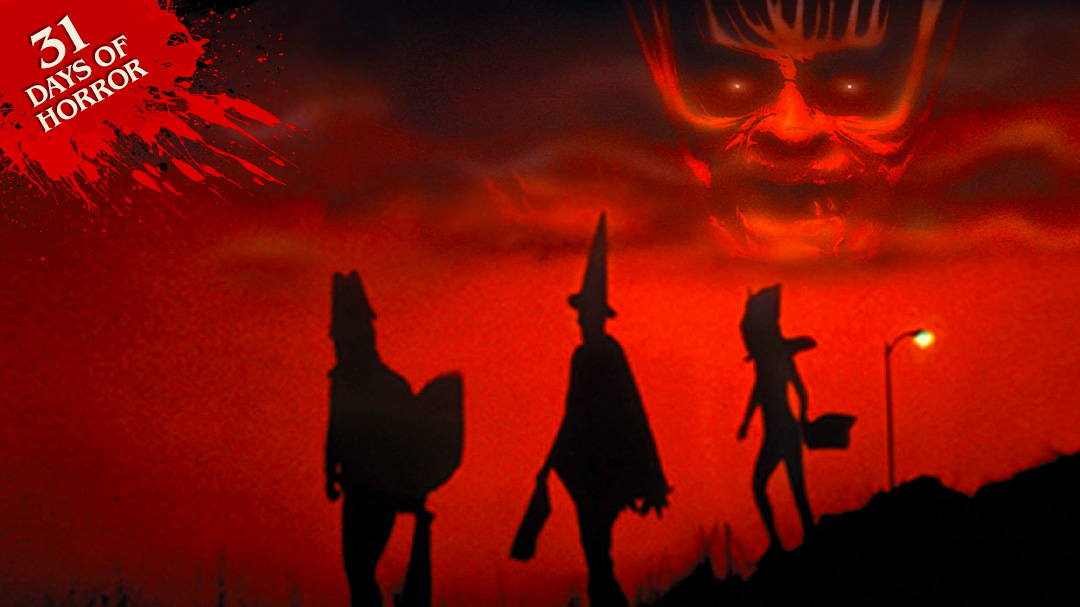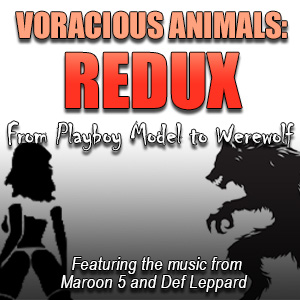Fear stalks the Outpost as All Hallows Eve dawns and our 31 Days Of Horror countdown concludes. Keeping us warm as the nights draw in, other than the sheer cuddliness of the Shawns, are Outposter contributions that warm our very souls. Here, the mysterious DwC, who walks among you in another form, gives us another edition of Masterpiece Theater. This time he tackles what is sure to be a firm favorite of any discerning Outposter. A true classic for this time of year. Halloween III: Season Of The Witch.
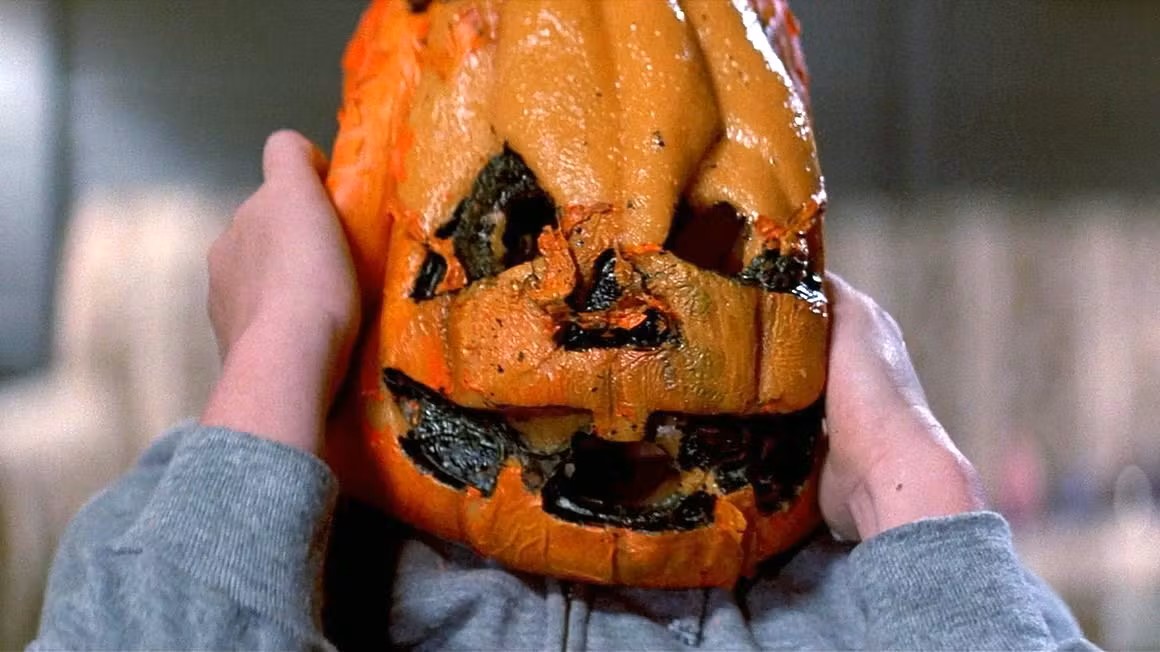
Halloween III: Season Of The Witch
A delirious man stumbles into an isolated gas station after eluding a group of mysterious pursuers and passes out. Upon being taken to a nearby hospital, clutching a Halloween mask and raving that “they’ll kill us all,” he is brutally murdered by an unknown assailant who promptly escapes to his car, douses himself in gasoline, and sets himself on fire, blowing himself and the car to smithereens.
In the following days the attending doctor, Dan Challis (Tom Atkins), and the man’s daughter, Ellie Grimbridge (Stacey Nelkin), embark upon an investigative journey that takes them to the small company town of Santa Mira, CA where they cross paths with Conal Cochran (Dan O’Herlihy), the reclusive owner of Silver Shamrock Novelties.

There they uncover a conspiracy involving an army of impossibly lifelike automatons, Stonehenge, and human sacrifice that threatens the entire nation’s children and their families. With time running out, Dr. Challis and Ellie race to thwart the evil plot before the clock strikes nine on Halloween night…
**Spoiler Warning**
Halloween III: The One Without Michael Myers. Let’s get that out of the way right now. There is no masked killer chopping up high school students in this film. No, this film has more to say. Much more. Sure, Halloween was a banger of a slasher/exploitation film, and part 2… uh, exists, but when backed into a corner and forced to come up with a third film, Carpenter, once again in the producer’s chair, lashed out and gave us a brutal critique (or possibly a warning?) of a society drowning in rampant consumerism in the early days of the commercialization of, well, damn near everything.
The earworm Silver Shamrocks jingle, the incessant radio, TV, and print ads for the hottest new thing are all deliberate choices made by Carpenter when crafting this masterpiece of a screenplay with director Tommy Lee Wallace and Nigel Kneale. Kneale was so terrified by the hellishly satirical vision of America he helped create that he demanded his name be removed from the credits.
Let us consider what it is that triggers a panic attack in the man, later identified as Harry Grimbridge (Al Berry), who was fleeing for his life at the start of the film: the airing of the Silver Shamrocks TV commercial in the hospital. This attack is so severe Dr. Challis must have him sedated. Once things calm down, Tom Atkins reminds us that this is 1982 by slapping the head nurse on the rear, who then confirms that it is indeed 1982 by acknowledging this as a friendly jest between two adults and laughs it off, because she’s not a stuffy, uptight lunatic.
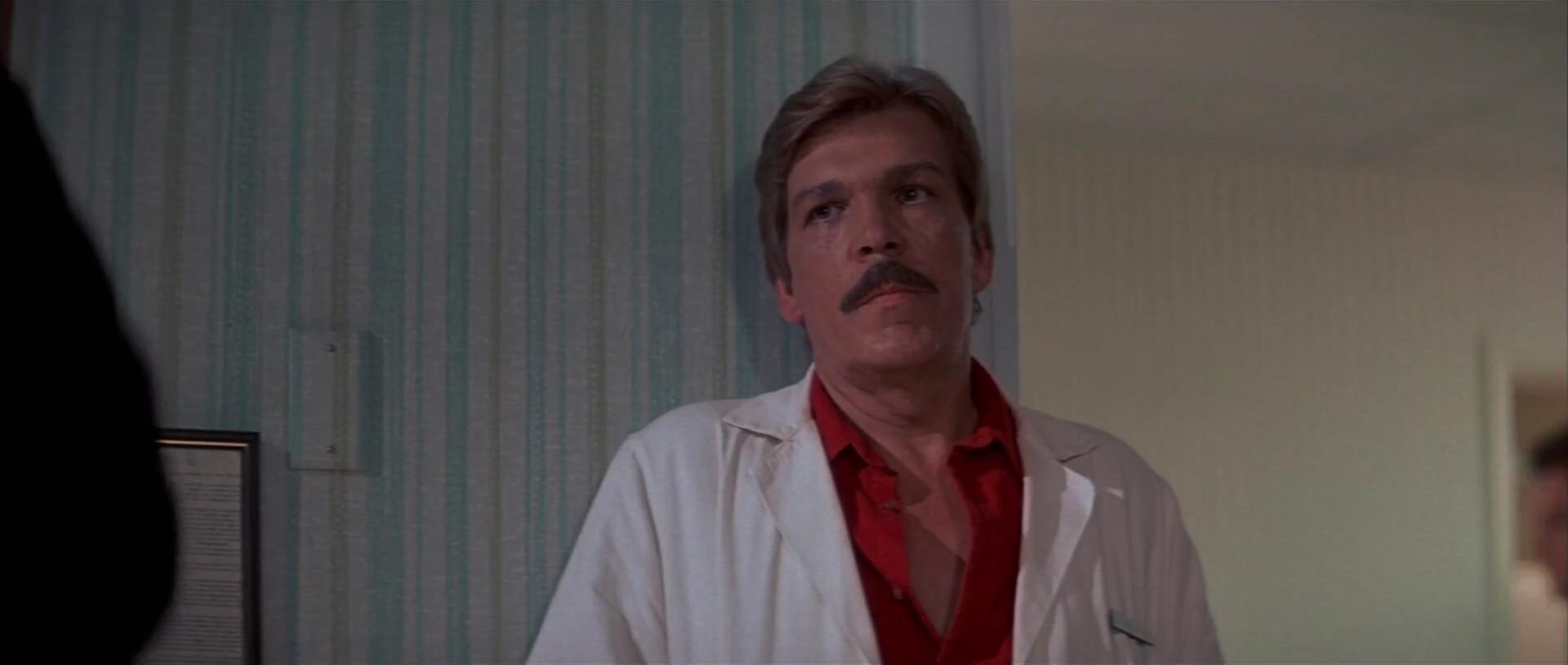
Before Harry Grimbridge can tell anyone what he knows, another suited man sneaks into his room, gouges out his eyes and “pulls his skull apart.” Dr. Challis, who will be damned before he lets someone commit murder in his hospital gives chase, only to see the man kill himself and his car by blowing it up while sitting inside. After the funeral, Dr. Challis is getting boozed up at the bar and yelling at the bartender to turn off the TV when Ellie Grimbridge comes in to thank him for all he has done.
After voicing his bewilderment over the events of that night, the two decide to do a little investigating. In Harry’s novelty shop his calendar reveals that he had to travel to the town of Santa Mira to pick up a last-minute shipment of Silver Shamrock Halloween masks, his last known whereabouts before the night of his death. Ellie vows that she won’t return to LA until she has answers, and since she is rather easy on the eyes, Dr. Challis quickly agrees to neglect his kids in order to accompany her to Santa Mira.
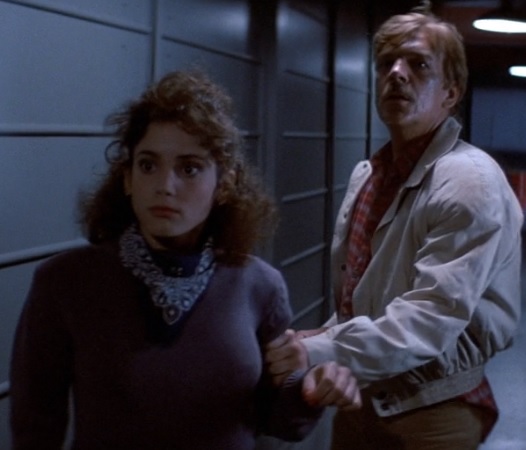
We cut to Dr. Challis on a pay phone outside of a liquor store getting shrieked at by his ex-wife (Nancy Kyes) as he explains he won’t be around until Halloween night. He hangs up and grabs his luggage off the top of the phone booth: beer. Because when Dan Challis is hitting the road to investigate a murder with a hot babe who is 20 years his younger, he only needs one thing, and that’s a sixer of Miller High Life tall boys.
On the way there we get some excellent exposition about Santa Mira, Silver Shamrock Novelties, and Conal Cochran, the secretive owner of the company. They check into a motel and eventually meet some of the other characters; gift shop owner Marge Gutman (Garn Stephens), and The Kupfer family; Silver Shamrocks salesman of the year Buddy (Ralph Straight), his wife Betty (Jadeen Barbor), and little Buddy Jr. (Bradley Schacter).
The portrayal of the Kupfer family is interesting, and they may at first appear to be there for comic relief, but nay nay, this family who appears to have walked straight out of an American family sitcom is going to help us understand just how high the stakes are a little bit later. In the meantime, Challis finds a clue; Harry’s name is in the motel registry. As night falls, Dr. Challis offers to get another room or sleep in the car, so Ellie doesn’t feel uncomfortable. Ellie, still shattered with grief over the death of her father just days prior, is feeling rather randy however, and lets Challis know there will be little to no sleeping on this trip.
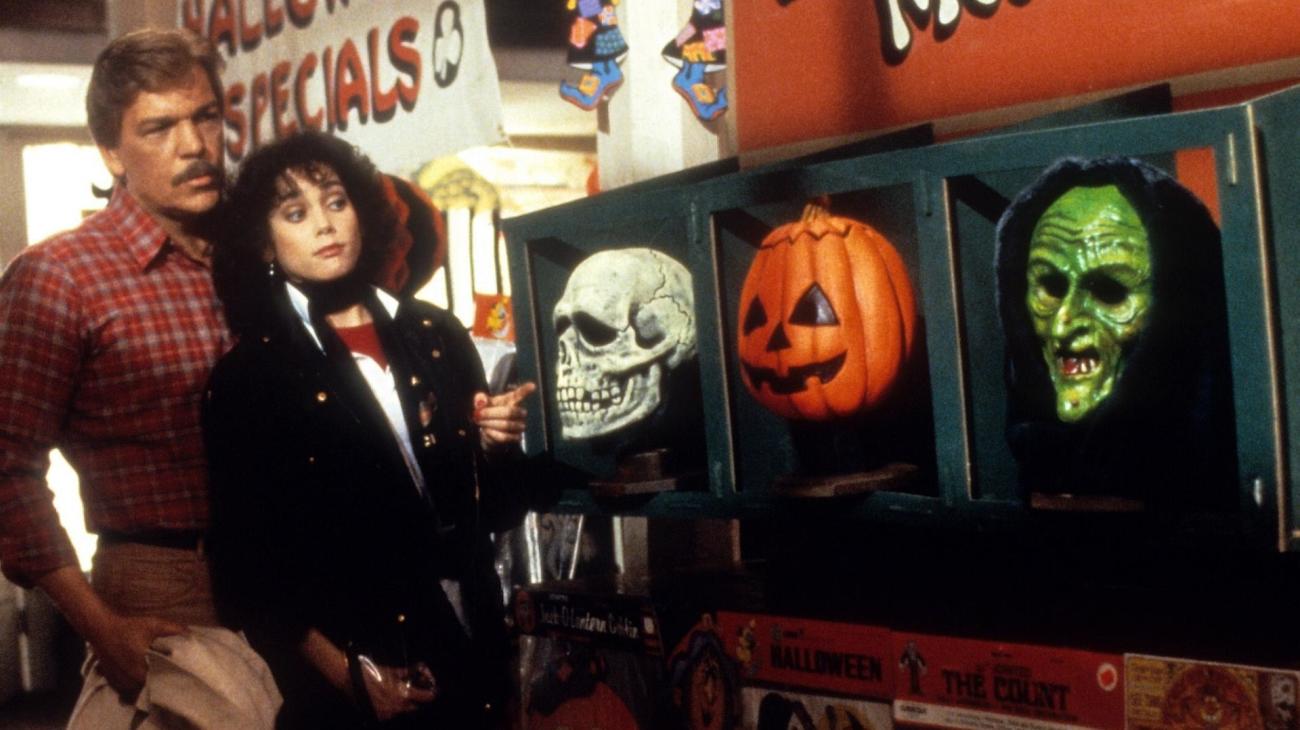
Having already crushed his six-pack, Challis runs out to pick up some more booze when he runs into a hobo (Jonathan Terry) on the streets of Santa Mira who asks for a drink and offers the flimsiest of assurances that he doesn’t have any diseases. Convinced, Challis happily lets this filthy homeless stranger have a drink from his bottle of hooch. The hobo offers up some exposition, telling Challis that Cochran bought up the town and staffed the factory entirely with outsiders, denying jobs to the local homeless population.
This scene serves as an excellent metaphor for how large corporations will move into a community and bring nothing but ruin, turning people into drunks who live in junkyards in the process. He points to the cameras everywhere, warns Challis that Cochran is watching him, then threatens to blow up the factory with a case and a half of Molotov cocktails before stumbling off to his junkyard shack for a dinner of Saltines and Cheez-Wiz, but his feast is interrupted by the same strange men who were after Ellie’s father.
The hobo pleads for his life and assures them he was just joshin’ around about firebombing the factory, but to no avail. The men hold him down and pull his head off, geysers of blood spraying everywhere. He has been decapitated; just as huge corporations decapitate the dreams of the residents whose towns they blight.
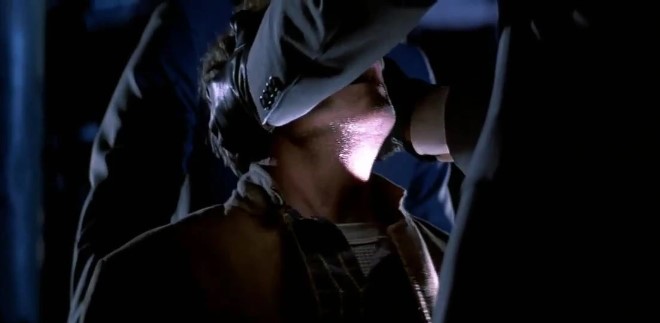
Challis returns to the motel room, where it’s revealed that Ellie took the time to pack some sexy lingerie on this trip to investigate the brutal murder of her father. She knew. She took one look at Atkin’s mustache, and she knew she would need that teddy. In the next room, Marge Gutman starts taking a closer look at the Silver Shamrock logo that fell off the mask she brought with her just as Challis and Ellie start round three of making the beast with two backs.
Challis, realizing he may be just a tad too old for Ellie, finally thinks it might be a good idea to make sure she’s actually an adult. Ellie offers the flimsiest of assurances that she’s older than she looks, and that’s good enough for Dan Challis. Next door, Marge is now digging around in a weird microchip-looking thing embedded in the mask, which triggers a laser beam to erupt from the chip. It blasts her in the face, causing the skin around her mouth to peel back and her eyes to turn blood red in a shockingly grisly injury. Just as she passes away, a cricket crawls out of her mouth.
Challis and Ellie are awakened by the commotion outside their room, so Challis goes to investigate and sees Marge being wheeled out on a gurney. He offers to help, as he is a doctor, but is rebuffed by the man himself; Conal Cochran, who assures Challis that Marge is going to receive the best care possible. In the factory. The factory that makes Halloween masks. This makes perfect sense, so Challis relents, but not before he overhears Cochran being told the incident was the result of a “misfire.”
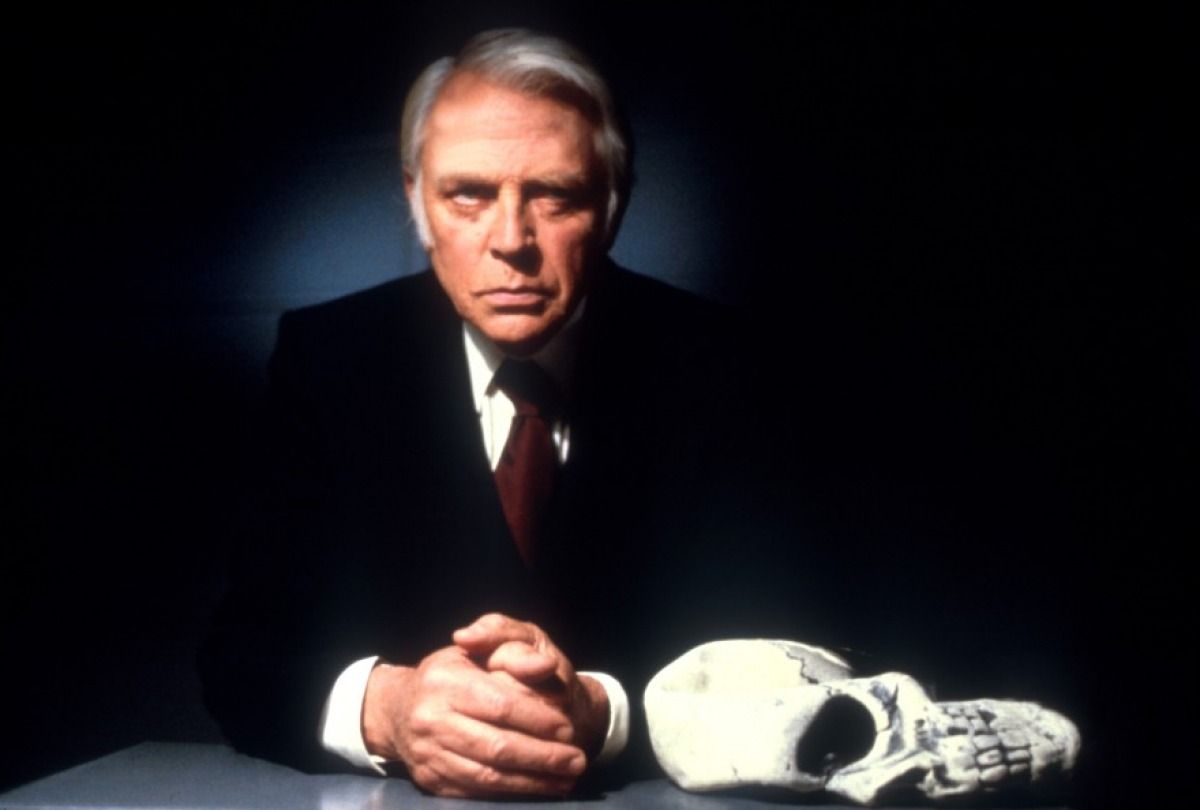
The next morning, they go to the factory to ask some questions about Ellie’s father and are greeted by the Kupfers, who are there to tour the factory as Conal Cochran’s personal guests. With a little pressure from Buddy Kupfer, Cochran invites “Mr. and Mrs. Smith” to join the tour. Here we see Cochran’s strategic thinking in action. At this point we know he’s up to no good, and that the masks are somehow involved, but just in case his master plan doesn’t work out this year, he has the factory running at full capacity making masks on Halloween day so they’ll be ready for next year when he can try again to unleash his sinister plot. Say what you will about the man, but you have to admire his ability to plan ahead.
As the tour is winding down, Ellie spots her father’s car in a garage being guarded by the strange besuited men and makes the mistake of drawing attention to herself. Ellie and Challis head back to the motel and prepare to leave town but first, Challis wants to call the police.
The phone in the motel office, however, no longer connects to any number outside of town. Realizing that they may be in more trouble than he thought, he runs back to the room and finds Ellie has been abducted by the sharp-dressed men, more of whom descend upon the room while Challis escapes through the bathroom window. Knowing there is only one place Ellie could be, he heads back to the factory to save her.
He breaks in and starts searching, eventually spying an elderly woman sitting in a dimly lit room, knitting, and dressed like a grandmother from 1940s eastern Europe. So, he does what anyone would do in this situation and begins to violently assault her, demanding to know where Ellie is. He is momentarily victorious when her head falls off, but quickly realizes she’s some sort of automated mannequin and can provide no information.
Momentarily distracted while gloating over his destruction of an old woman, Challis is beset by one of the killers in a suit. Challis beats the hell out of the man and attempts to disembowel him, but once his fist penetrates the man’s abdominal cavity, he pulls out nothing but circuitry and wires, and yellow goo starts pouring from his mouth. This is not a man, but an incredibly life-like automaton. Challis is captured and led to the secret “final processing” room, which is in actuality a giant control center with computers, automatons, and a giant fuckin’ piece of Stonehenge in the center.
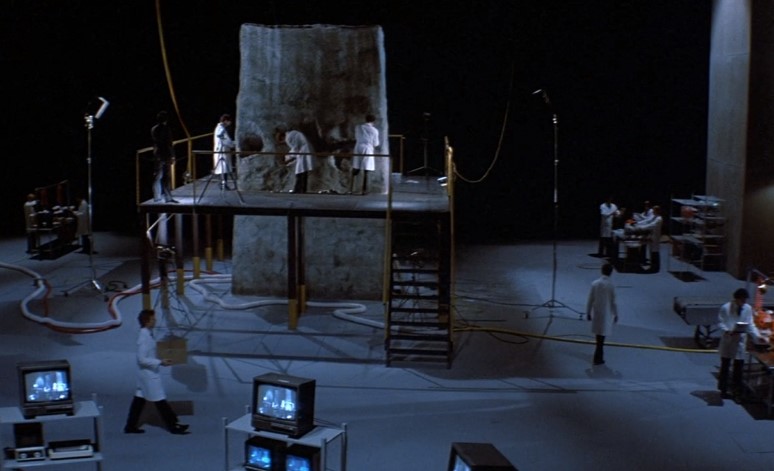
You may be wondering how a stolen, twelve-thousand-pound piece of Stonehenge made its way to California, but Cochran assures us it was difficult, and no one would believe him if he did explain it so he’s not going to bother. Plot hole status: filled.
Cochran then turns on a monitor revealing Ellie strapped to a gurney in a room nearby while explaining to Challis that even the smallest piece of the Stonehenge monolith has a power that if harnessed, is devastating. But, he informs Challis, that what he really needs is a demonstration. Cut to the Kupfer family being led into a “test room” that is set up like a typical living room. What follows is possibly the most hellishly disturbing scene in the history of cinema.
It’s a well-known screenwriting rule that a film with a serious antagonist needs a scene that establishes just how evil that villain is. In Die Hard, for example, that scene is when Hans Gruber shoots Takagi in the face. In Pan’s Labyrinth, it’s when the Captain hammers the peasant’s head into mush with a bottle. And in Ghostbusters 2016, it’s when Leslie Jones screams at the audience for 2 hours then spends the next seven years trying to convince us it’s comedy.
In Halloween III, that scene is the following: once the Kupfers are locked in the test room, the TV turns on and the Silver Shamrock commercial begins, prompting little Buddy Jr. to put his mask on. The signal beaming into the room reacts with the magic Stonehenge particles embedded in Buddy’s mask and triggers a reaction. Little Buddy grabs his head and collapses onto the floor in agony, his open eye visible through the melted mask.
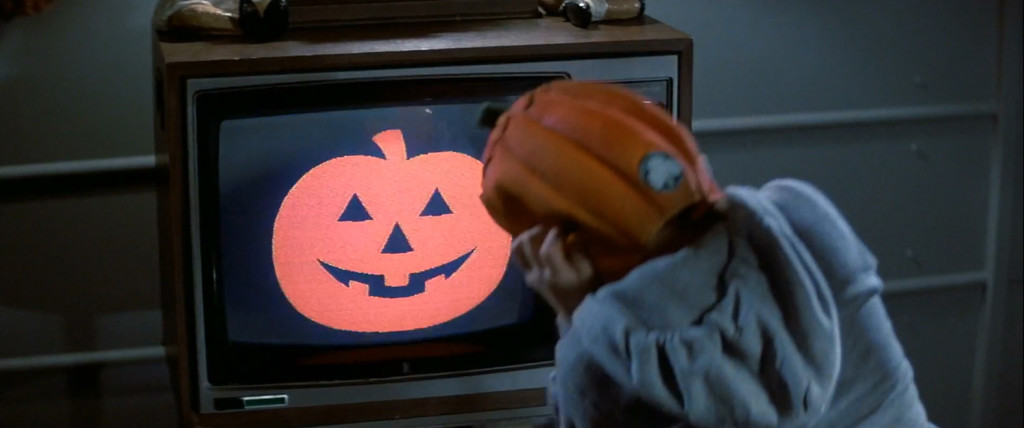
Suddenly a flood of insects and venomous snakes pour from Buddy’s ruined head and attack Buddy Sr. and Betty, killing them both.
Challis nearly collapses as the film cuts to children across the country trick or treating while wearing their Silver Shamrock masks. All of them eagerly looking forward to getting back home to watch Silver Shamrocks’ “Big Giveaway” at 9pm, completely unaware that they all have weapons of magic mass destruction clamped on their heads.
I was impressed by how Carpenter expresses his disdain for time zones by purposely ignoring that they exist in this world. If it’s nine o’clock in California, it’s Goddamn nine o’clock everywhere.
Back at the factory Cochran has Challis strapped to a chair in front of a television. He’s going to put one of the masks on him so he can suffer the same fate as little Buddy when Challis asks: “Why Cochran, why?” Conal Cochran responds with the greatest monologue ever written, literally the best thing to happen to talkies since ears, about the origins of Halloween. My words cannot do it, or Dan O’Herlihy’s performance justice, but it is absolutely chilling.
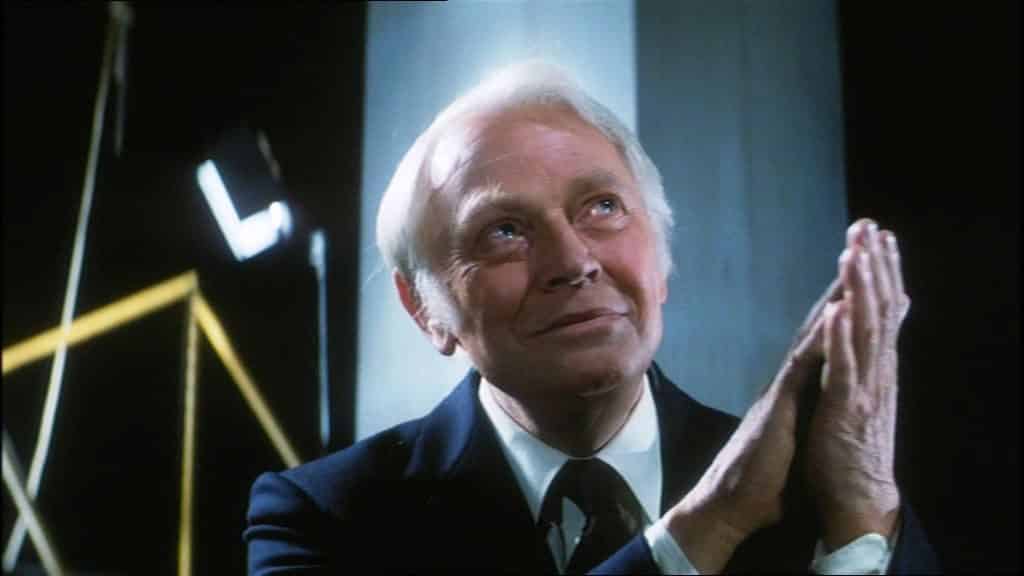
The menace with which he delivers this dialogue is astoundingly effective, and if horror was taken more seriously, the best-supporting actor statue would have surely gone home with him the following March.
Challis, now understanding exactly what’s at stake, is determined to stop Cochran. He gets his mask off and easily flicks it onto the camera in the room and escapes his bonds. He grabs the nearest telephone to call his ex-wife and warn her that the masks she bought their kids are going to kill them but, in typical ex-wife fashion she doesn’t listen, and instead starts ragging on him about his drinking. Again. Jesus Christ, no wonder he divorced her.
Realizing he can’t talk sense to this hysterical woman he hangs up the phone and goes to rescue Ellie. Once he does, the two of them start working their way back to the control room to stop the evil plan. They take cover behind a cart full of masks and use it as camouflage to make their way across the control room floor, because a giant cart that’s 8 ft tall, 6 ft wide, full of colorful Halloween masks and moving across the room on its own accord is infinitely less conspicuous than two people hiding in the shadows while wearing dark clothes.
Challis then spots a damaged box of Silver Shamrock magic death logos and gets an idea; he sneaks by the killer robots, turns on the monitors, then runs up the stairs to drop the magic death logos onto the floor inside the circle of monitors. The TVs all aligned in a circle create some kind of vortex of Stonehenge evil that short circuits and destroys the robots before it becomes so strong it links to the Stonehenge pillar, creating a beam of power that vaporizes Conal Cochran before the monolith explodes.
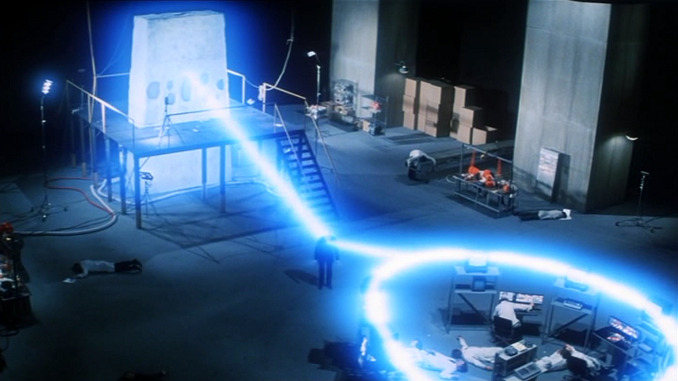
Before he fades out of reality, Cochran gives Challis a golf clap, truly impressed by his efforts. His work not done, Challis heads out of town with Ellie to try and stop the broadcast of the commercial. He realizes Ellie hasn’t said a word since he rescued her and asks if she is ok, just as the Silver Shamrock commercial on the car radio triggers the now-robot Ellie to attack Challis.
He wrecks the car and a fight between Challis and the Ellie-bot ensues. He uses a tire iron to knock her head off, but she keeps coming. He finally subdues her but when he gets in the car her sentient disembodied arm tries to strangle him. These are highly advanced robots. He throws it out the window and makes his way to the same gas station from the beginning of the film in a scene that mirrors the opening. As the Big Giveaway starts playing, he grabs the phone and frantically calls the… cable company(?) and demands they take the commercial off the air.
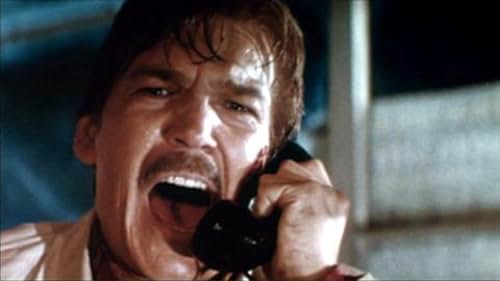
Not one to ignore the incoherent ramblings of a total stranger on Halloween night, the cable company complies, and the TV goes to a test pattern, but the stupid kids who just walked into the gas station to get candy turn to the next channel just as that one cuts out too. They turn to the third channel, but the broadcast doesn’t cut out this time as Challis desperately screams into the receiver; “Stop it! Stop IT! STOP IIIIIT!” The screen cuts to black as his frantic cries echo, then go silent.
An Anthology Of Awesome
A lot has been written about this film, unfortunately most of it by idiots who didn’t get what Carpenter was trying to do.
The theme of mass consumerism has been tackled before but never with such urgency. Here, Carpenter puts forth a premise in which an entire population is led to its doom by clever marketing, similar to what happened this past summer with Barbie.
Take the Kupfers for example; as mentioned earlier this is a typical American family straight out of a sitcom, pure 1980s Americana. Carpenter destroys them without mercy in a metaphor for what too much TV and too much material consumption is doing to our very souls, visualized in excruciating detail and hammered home with that delightful Silvers Shamrock jingle.
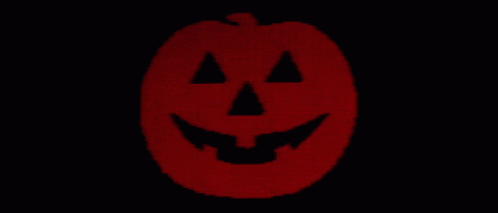
What also impresses me about this film is that with very minor script changes it could have been the greatest James Bond movie ever made. Challis as Bond, Harry Grimbridge as another 00 agent whose death kicks the plot into motion, Ellie is your Bond Girl, and we even get the evil supervillain explaining his plan and his motivations to the hero before leaving him unattended to be killed in unnecessarily complicated fashion. It’s truly marvelous how Carpenter and Kneale channel Fleming to craft a confrontational indictment of commercialism and rampant consumerism, laying the groundwork for what was to come several years later in They Live.
The ever-reliable Dean Cundy photographs the proceedings with his masterful eye as usual, and Tommy Lee Wallace does an admirable job of capturing that Carpenter aesthetic.
Dan O’Herlihy makes for one the greatest villains to ever grace the silver screen, going from affable and friendly to sinister and menacing in a moment’s notice with just a furrow of his brow and twitch of his mouth. But it’s Tom Atkins who truly shines with his unique blend of swagger and gravitas that few other actors have ever been able to match. I’m shocked Atkins never became a leading man on par with Mel Gibson or Kurt Russel, because he plays the gruff, borderline alcoholic anti-hero just as good, if not better, than any of them.
It’s taken over thirty years, but the world is finally catching up to the brilliance of Halloween III: Season of the Witch. I just hope that, like Dr. Challis, we’re not a few seconds too late.
14 killer magic head cobras out of 10
Check back every day for movie news and reviews at the Last Movie Outpost



